Effects of Sub-clinical Anxiety Levels
Added on 2021-05-30
39 Pages8262 Words18 Views
Chapter four1.Abstract1.1Purpose of researchThe main objectives of our research are:i.Establish the effects of sub-clinical anxiety levels on information processing speeds ii.Examine Intra-individual variability among members of different gender and age groups specifically young and old adultsiii.To investigate the different factors that influence decline of cognition at both young age and old age and determine whether they are controllableTo enable us achieve this objectives we drafted a set of research questions which we intend to answer along our research as well as draw conclusions and insights from ourfindings.1.2 Research questionsi.Is there a relationship between age and cognition abilityii.What are the factors that cause decline cognabilityiii.What is the effect of anxiety on information processing speeds among different individuals?iv.What is the effect of anxiety on intra-individual variability in younger and older adults?v.Are there different information processing speeds among members of the same age group but of different genders?

vi.What is the Intra-individual variability among:Members of different age groupsMembers of different sex but same age group1.3Research designOur research is divided into nine sections:i.Abstractii.Introductioniii.Methodologyiv.Resultsv.Discussionvi.Research Limitation vii.Recommendation Further researchviii.Conclusionsix.Bibliography1.4.Major findings and TrendsAfter conducting our research study we found out that:i.There are a number of factors that influence the speed of information processing and intra-individual variability among members of the society I.e. the young and the oldii.There are emerging trends in medicine worth exploration, for instance the neuro-imaging technique that aid in presentation of a better view of the neural systemKeywords: non-clinical anxiety, information processing speed, Visual search, intra-individual variability, subjective and objective cognitive function, younger

adults, older adults, maladaptive, adaptive.2.IntroductionDisorders related to anxiety, entail a significant number of health concerns globally . However, it does not stop with the discomfort of the affected individuals alone but equally has far-reaching social-economic consequences such as the costs required to treat the affected and the feeling of social misfitting that comes with the illnesses notwithstanding the fact that their productivity is impaired , Beddington et al. (2008). Studies done by Robinson et al. (2012) suggest indicators of anxiety to be wide ranging from Hyper-arousal to difficulties in concentration. Additionally, they argue that these kind of disorders do elevate debilitating focus upon life-events as well as obscure concentration therefore rendering anxiety to be maladaptive in such cases. Nevertheless, it is not always grumpy for anxiety since it can be used to perceive and avoid danger hence adaptive. The purpose of our research is to investigate and report on the influence of sub-clinical anxiety levels on information processing speed and intra-individual variabilityin younger and older adults. Using Tales et al.’s (2010) visual search research method we will review:i.Genderii.Ageiii.sub-clinical effects on anxiety levelsiv.Visionv.Handedness
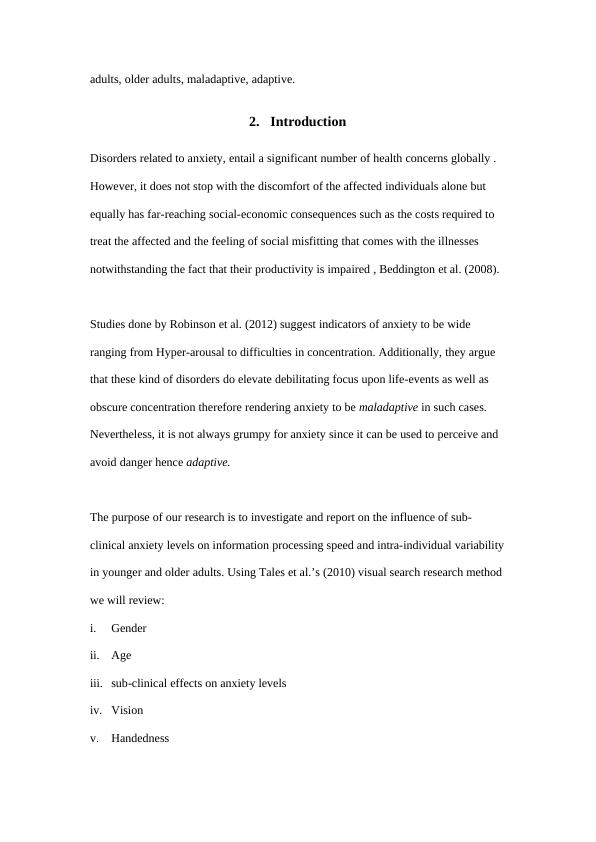
vi.subjective memory functionvii.objective cognitive functionIn connection to information processing speed and intra-individual variability in younger and older adults. Our research will be a build up of previous studies done using the same task to measure cognitive processing in healthy aging. However, as opposed to previous similar researches. Studies by: Landy et al (2015); Gottlob et al (1999); Tales et al (2010) and Kiss et al (2012) examines information handling amongadolescents and older adults. Exploring effects of the aforementioned factors such as age on information processing. The five studies will form an integral part of our research, this will enable us explore previously neglected studies or under-examined studies on factors influencing information processing. As stated earlier our research questions include:Research Questionsi.Is there a relationship between age and cognition abilityii.What are the factors that cause decline cognabilityiii.What is the effect of anxiety on information processing speeds among different individuals?iv.What is the effect of anxiety on intra-individual variability in younger and older adults?v.Are there different information processing speeds among members of the same age group but of different genders?vi.What is the Intra-individual variability among:Members of different age groupsMembers of different sex but same age groupGiven this framework for research, we will therefore be able to establish the major
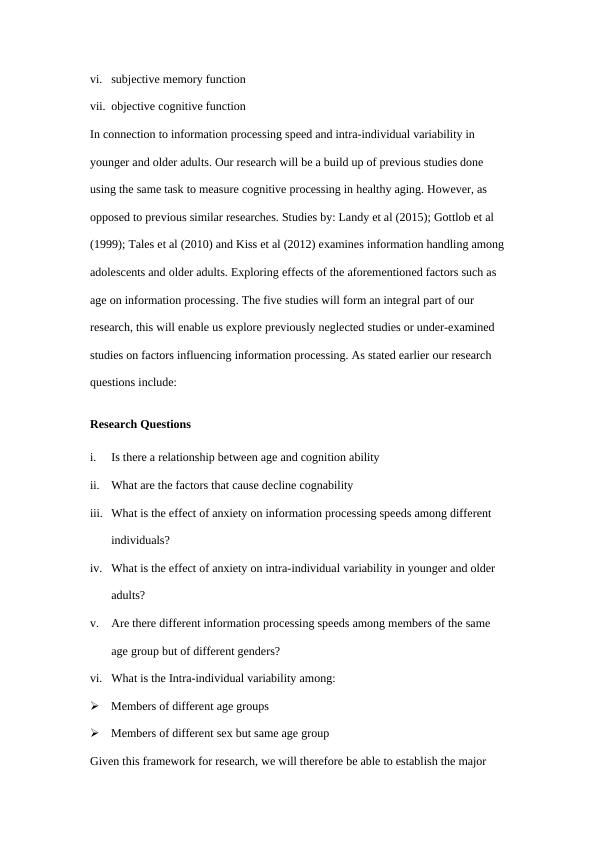
factors that influence visual search.Cognition and anxietyCognitionCognition is generally referred to as information processing, the term is coined from cognoscere a Latin name for “recognize”. Therefore, cognition is the processing of instructions or messages from the outside environment/ world and regulating how to utilize that information raises its adaptability and productivity success. In our study we determine factors that affect cognition i.e information processing. There are two base categories of cognition:i.Cold cognition- involves neutral informationii.Hot cognition- involves affective information and hence can be maladaptive and adaptive i.e. it is emotionally dictated(valenced)AnxietyDavis et al.(2010) defines anxiety as “response to prolonged and unpredictable threat, a response encompassing physiological, affective, and cognitive changes.” therefore we may view anxiety as distinct from fear since they are dis-sociable at behavioral, neutral, and pharmacological level (Grillion et al., 1991; Davis et al., 2010; Grillion, 2008). In this study, we will explore how anxiety influences the cognition speeds. Generally, anxiety sensitizes sensory cortical systems (Robinson et al. 2012) to innocuous environmental stimuli. It is this stimulated response component that is projected to reflect preattentive change direction (Ge et al, 2011).Majorly we will explore how the levels of anxiety vary from young to older adults

and establish how this variability affects cognition in the subgroups of interest.Sensory perceptual processesThis are the basis of all cognitive processes. Therefore, Sensory perceptual processes are the immediate processing and perception of environmental stimuli. Information processing speedRefers to the ease with which the cognitive brain reacts to external stimuli.Generally,Information processing speed is measured as part of the diagnosis ofdementia and Mild Cognitive Impairment (MCI). In normal aging, the brain functionsslow down while intelligence measures stabilize, and ability for recall decreasessignificantly. Research evidence indicates that information processing speed can varysignificantly with respect to methodological factors such as the task used; thus theareas of the brain recruited for performance and response demands (Rodrigues &Pandeirada, 2014; Valeriani et al., 2003), person-related factors such as sex(Commmodari & Guanera, 2013), education (Tales & Basoudan, 2016), and possiblygenetic factors (Luo et al., 2017). Interactions between these factors can result insignificantly different impacts on processing speeds, depending on specific brainareas required for the performance of tasks (Tales et al., 2010; Tales & Basoudan,2016). Previous researches suggest an existence of an association betweeninformation processing speed and the functional integrity of both cognitive and ofneuro-anatomical (Anstey et al., 2007; Haynes et al., 2017; Kennedy et al., 2013;Lövdén, Shing & Lindberger, 2007; Voelker et al., 2017). Additionally studies onNeuro-anatomical have identified age-related differences in the inter-hemispheric datatransfer rates and activation, as well as differences in white matter integrity; olderadults demonstrate greater transfer rates than younger ones, possibly as a
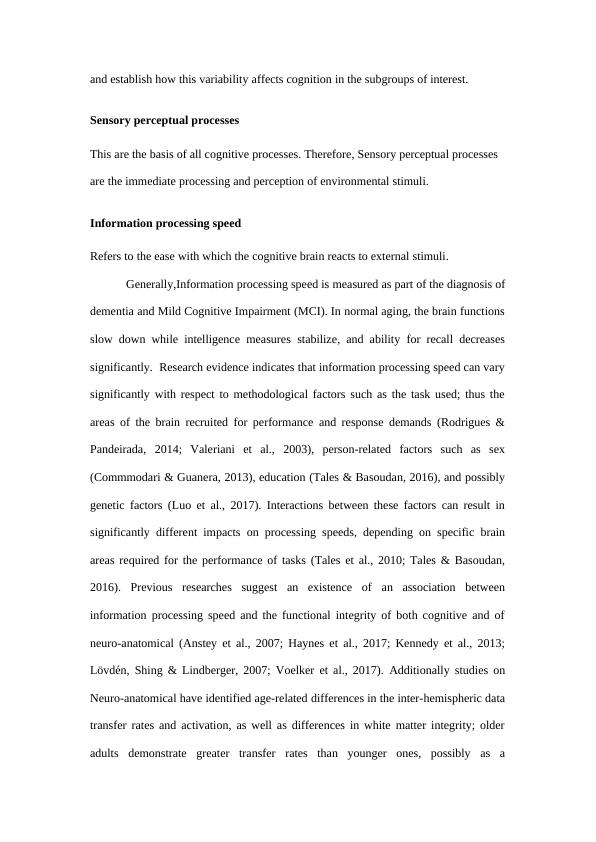
compensatory strategy to overcome ageing-related cognitive declines (Anstey et al.,2007; Haynes et al., 2017). These differences are identifiable using reaction time tasksas fundamental measures of both inter-hemispheric transfer and cognitive changes dueto ageing (Antsey et al., 2007).Subjective Cognitive FunctionAn important factor though rarely has it been considered for the investigationof information processing speed in ageing and ageing-related disease is the subjectivecognitive function. Although most studies examining information processing speed inageing measure and factor in the potential influence of objectively measured status ofcognitive function, it is rare for research results to consider how subjective feelings orassessment of the cognitive function may influence information processing speed.Objective measures of poor general cognition are often found to be related to slowerinformation processing speeds, compared to intact cognition in older adults (Tales &Basoudan, 2016). It is possible that subjectively poor cognition, by itself and incombination with anxiety, may also affect information processing speed (eitherthrough similar or different mechanisms, yet to be fully identified). If this is the case, then both clinical and research findings would need to beinterpreted with respect to this caveat also. As mentioned above, a further aim of thisstudy is to determine whether in older adults, either objectively-measured orsubjectively-experienced cognitive function influences information processing speed.Finally, the potential influence of sex (male/female) and educational level uponinformation processing speed will also be investigated.
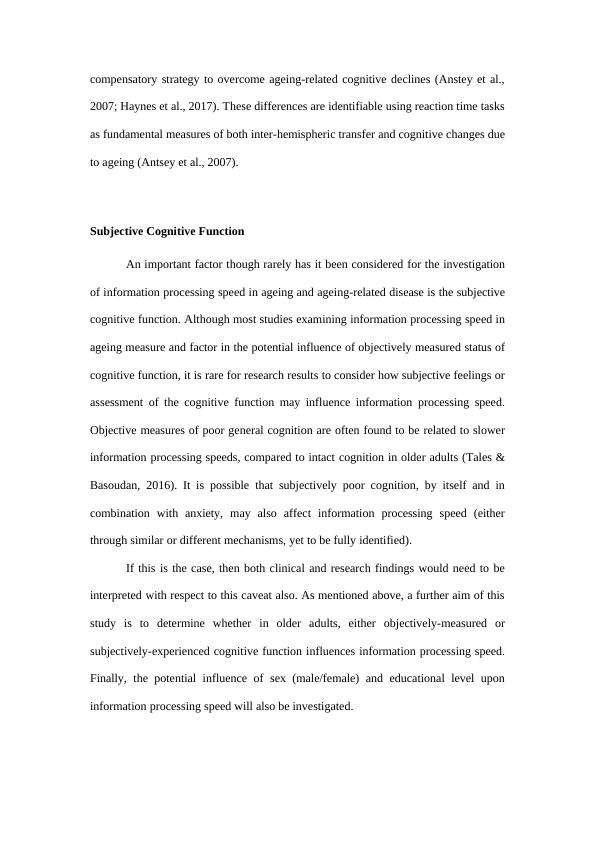
Visual SearchAccording to Commodari, & Guarnera, (2013), Visual Search refers to the applicationof vision to search different objects and articles. This indicates that it has direct relationship with selective processing information and selective attention. Therefore itserves as an important task not only for humans, but also for animals, birds and even insects, as all these creatures seek help from vision to see, examine and use objects forvarious purposes. The Single Detection Theory demonstrates how visual attention has its impact and influence on tasks involving search of the targeted objects among distractors. The studies conducted on the topics of physiology and psycho-physics reveal that performance in a search task is largely determined by the discriminating ofthe target from the distractors. Hence, the object being searched contains unique or dissimilar characteristics, including size, colour, mass and shape, an image of which has developed in brain, and helps the individuals in searching and finding the requiredobject among the distractors, while seeking support from selectively processed information. Hence, attention plays a dominant role by increasing the response to the attended stimulus, by confining the search to the specific traits of the object under-consideration among distractors.Verghese (2008) argues that both these processes improve the search performance by increasing the ability to discriminate the attended signal. Eckstein (2011) notes that the real significance of visual search can be understood by its application as a common tool for identification as objects by humans and animals, and for studying the topics related to cognition ranging, decision-making, circumlocutory control to memory, rewards and active vision on thepart of the humans. Generally, he further argues that, visual search looks to be a simple and easy task for the individuals; consequently, computer engineers and scientists appear to be interested in recreating human visual search abilities in
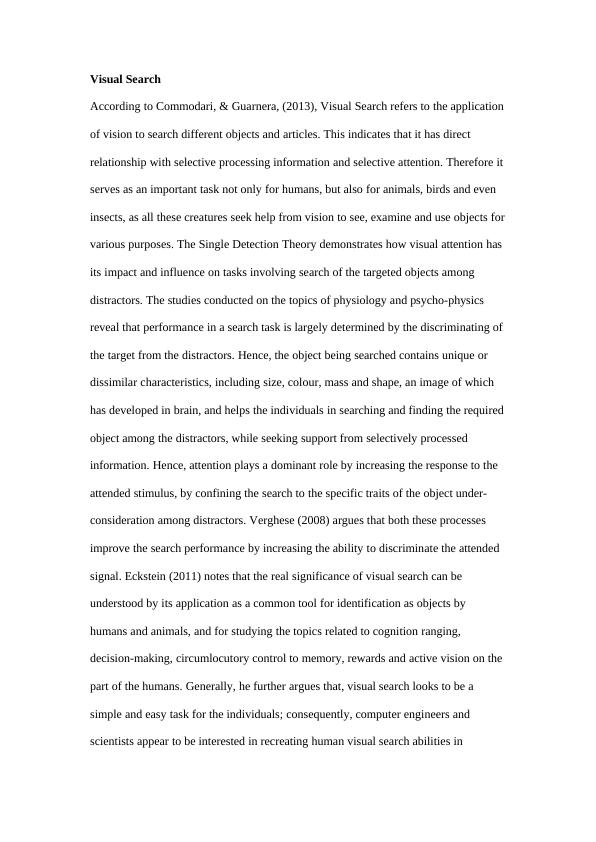
End of preview
Want to access all the pages? Upload your documents or become a member.
Related Documents
Visual Search and Information Processing Speedlg...
|46
|13333
|304
Effects of Anxiety on Different Aspects of Information Processinglg...
|34
|10399
|104
(PDF) Anxiety disorders in older adultslg...
|34
|9370
|58
Difference in Non-Clinical Anxiety Levels between Young and Older Adults and in Respect to Depression, Cognitive Functions and Demographic Parameterslg...
|34
|10472
|446
Anxiety, Reaction Time, and the Variability of Reaction Time in Younger and Older Adultslg...
|91
|11426
|49
Difference in Simple Reaction Time of Young versus Old Adultslg...
|1
|371
|64
